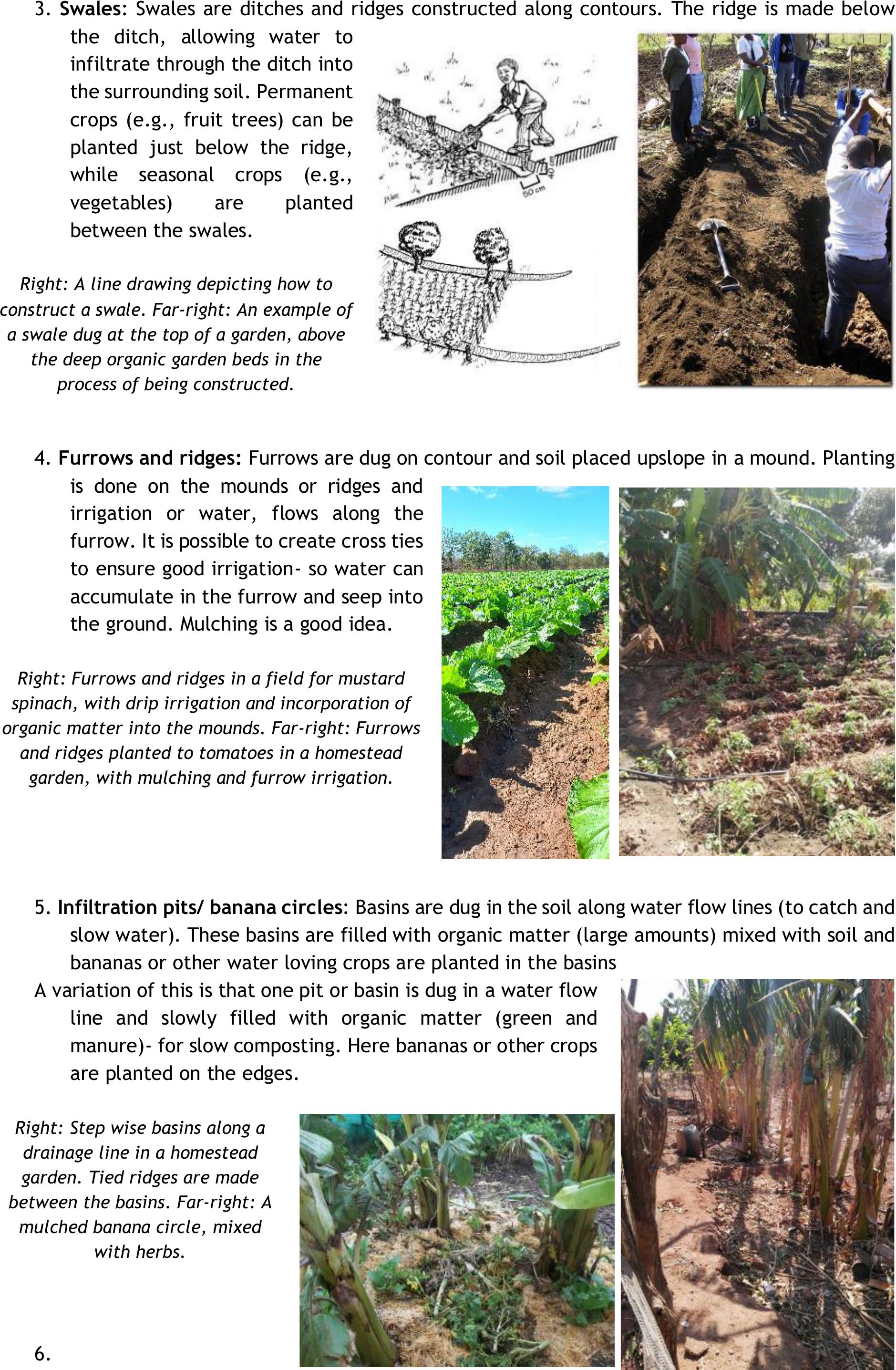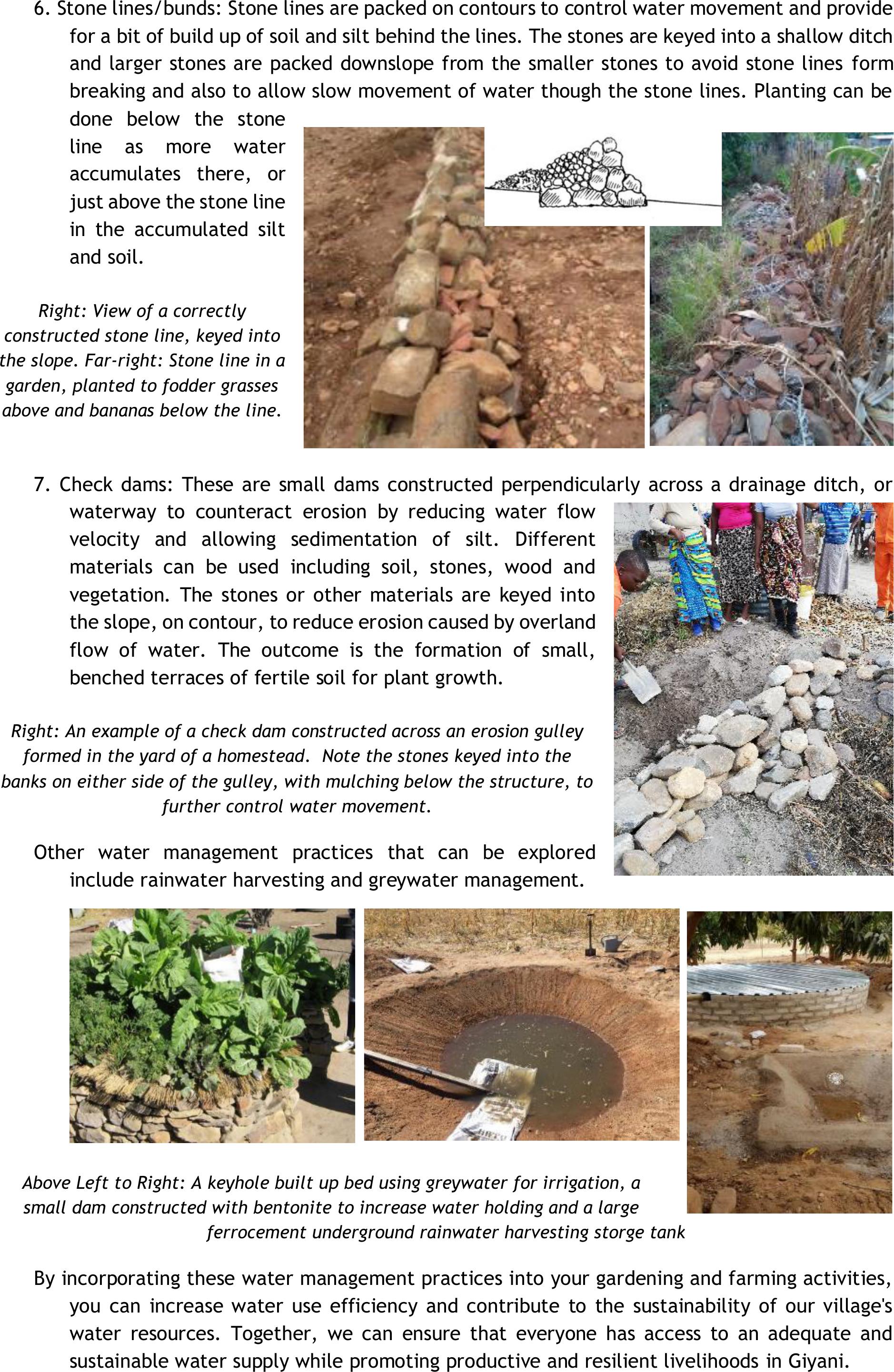
Guidelines for Water Use in rural villages of Giyani
Introduction
Water is a precious resource in ourvillages,and its availability varies among households. To
ensure equitable and responsible water use,we have categorized households into four groups
based on their access towaterresources and infrastructure.These guidelines are intended
to help each group make the most efficient and sustainable use of the available water for
household purposes, small livestock, household gardens, and small businesses.
The water services and access options aredifferentdepending on the area and village.In Limpopo
water schemes generally provide water either at communal collection points or through
communal standpipes. Yard connections in homesteadsare extremely rare.Reliability and
continuity of water supply is an issue and householders often have to go long periods without
water.Private and individual arrangements for access from springs, streams and boreholes is
common for those householders who can afford this.
Water access options
Group 1: 20-40L per person/day allocation
These households are extremely vulnerable, consisting mostly of woman-headed households,
pensioners, 'foreigners,' or new entrants into a village. They relysolely on communal water
access points and have little tono water storage options at household level. This group usually
makes up around 15-25% of the households in a village. Here are some guidelines for group
1:
1. Prioritize basic needs before otheruses: Use water primarily fordrinking, cooking, personal
hygiene, and sanitation.
2. Limit water use in households: Reduce any losses and wastage immediately and use water-
saving-and-sharing rules in the household.
3. Collaborate with neighbours: Cooperate with nearby households to ensure the communal
standpipes are used efficiently and that taps are not left running.
4. Explore community support: Seek assistance from community initiatives and organizations to
improve water access.
Group 2: <70L per person/day
These households have access tostandpipes close to, or in their homesteads (private), have
access to limited water storge optionsand can undertake some productive activities, such as
small home gardens. Around 25% of households are in this category.They have enough water
for general household use and can supplement their food supply to some extent.
1. Household needs first: Prioritize basic household use, including drinking, cooking, and
sanitation.
2. Maintain small gardens: Use extra water for small home gardens to supplementyour food
supply.
3. Water conservation: Implement water-saving practices like mulching, drip irrigation,
greywater management and rainwater harvesting.

4. Support the community: Share knowledge and resources with neighbours in Group 1 to help
them improve their situation.
Group 3: ~100L per person/day
This group is functionally similar to Group 2, but with better storage options and more productive
activities such as slightly larger (around 200m2) householdsgardens,than those in Group 2.
Approximately 24% of the community falls within this category, and someof these households
also have traditional poultry, or other small livestock such as goats.
1. Balance needs: Prioritize essential household needs while maintaining slightly larger gardens
(around 200m2).
2. Improve garden efficiency: Implement advanced gardening techniques like crop rotation and
soil improvement to maximize yield.
3. Water management: Implementwater conservation strategies and efficient irrigation methods
and monitor water usage to prevent wastage
4. Collaborate: Share successful gardening practices with neighbours in Group 2 and Group 1 to
help them improve their productivity.
5. Consider small livestock: Explore keeping traditional poultry or small livestock if suitable for
yourcircumstances.
6. Support the community: Shareknowledge and resources with neighbours in Groups 1 and 2 to
help them improve their situation
Group 4: >200L per person/day
Households in this category have private boreholes or water sources,in addition to the communal
options, with betterwater storage options and can maintain well-established gardens, small
livestock (chickens, goats), large livestock and small, diverse fruit orchards.
1. Sustainable practices: Continue prioritizing household needs, maintaining healthy gardens
(200-400m2), and supporting small livestock (chickens, goats).
2. Water management: Implement water conservation strategies and efficient irrigation methods
and monitor water usage to prevent wastage.
3. Diversify your garden: Cultivate a variety of fruits, vegetables, and herbs toenhance your self-
sufficiency.
4. Community leadership: Shareyour knowledge, expertise and resources with othergroups to
help them improve their water management and productivity.
General Guidelines for All Groups
1. Fix leaks promptly: Regularly check for and repair any water leaks to prevent water wastage.
Do not allow community standpipes to waste water.
2. Rainwater harvesting: Consider installing rainwater harvesting systems to supplement your
water supply, especially during the rainy season.
3. Community cooperation: Support community water management initiatives andcollaborate
with neighbours tooptimize water access and use.
4. Education and awareness: Continuously educate yourself and your family about water
conservation and sustainable practices.
5. Manage and regulate use of borehole water toreduce the danger of over pumping and
salinization.Pay attention topotential sources of contamination of groundwater in and
around your homestead and borehole.Also pay attention to theneed for groundwater

recharge by minimizing soil erosion and run-offand maximizing water infiltration around
boreholes and in the village as a whole.
Water Management Practices (Kruger, et al., 2021)
Good water management practices are essential for water use efficiency and enhancing water
availability in both gardens and fields. Many practices have both soil and water components. Here
we focus on those practices that increase water in the soil in situ water harvesting, increase
infiltration and increase water holding capacity. Practices are applicable in both garden and field
cropping contexts.
Consider the following practices:
1. Site Assessment: Begin by conducting a joint assessment of your site and water flow patterns
to identify areas where
runoff and watershould
be managed. Introduce
the concept of contours
(see guidelines) and how
they can be measured.
Right: A diagram showing how to
take water flow, aspect and wind
into account during planning and
designing a garden or field
2. Diversion Ditches:These ditches carry water from places where there is too much run-off to
areas where you would like to use the water–through infiltration into the soil. You can for
example divert wateroff a local road into fruit tree basins to both reduce erosion and improve
water availability. Ditches 30cm deep and 30cm wide aredug at a shallow gradient -1,5-3%
to channel water to beds in the garden or field. Planting canbe done in the ridge, adding
manure and compost and mulching of both ridges and ditches is a good idea.
Right: A diversion ditch
mulched and planted to
sweet potatoes, leading
from the road towards fruit
tree basins. Far right:
Digging the ditch while
placing soil upslope to
create a ridge.

3.Swales: Swales areditches and ridges constructed along contours. The ridge is made below
the ditch, allowingwater to
infiltrate through the ditch into
the surrounding soil. Permanent
crops (e.g., fruit trees) can be
planted just below the ridge,
while seasonal crops (e.g.,
vegetables) are planted
between the swales.
Right: A line drawing depicting how to
construct a swale. Far-right: An example of
a swale dug at the top of a garden, above
the deep organic garden beds in the
process of being constructed.
4. Furrows and ridges: Furrows are dug on contour and soil placed upslope in a mound. Planting
is done on the mounds or ridges and
irrigation or water, flows along the
furrow.It is possible to create cross ties
to ensure good irrigation- so water can
accumulate in the furrow and seep into
the ground. Mulching is a good idea.
Right: Furrows and ridges in a field for mustard
spinach, with drip irrigation and incorporation of
organic matter into the mounds. Far-right: Furrows
and ridges planted to tomatoes in a homestead
garden, with mulching and furrow irrigation.
5. Infiltration pits/ banana circles: Basins are dug in thesoil along water flow lines (to catch and
slow water). These basins are filled with organic matter (large amounts) mixed with soil and
bananas or other water loving crops are planted in the basins
A variation of this is that one pit or basin is dug in a water flow
line and slowlyfilled with organic matter (green and
manure)- for slow composting. Here bananas or other crops
are planted on the edges.
Right:Step wise basins along a
drainage line in a homestead
garden. Tied ridges are made
between the basins. Far-right: A
mulched banana circle, mixed
with herbs.
6.

6. Stone lines/bunds: Stone lines arepacked on contours to control water movement and provide
for a bit of build up of soil and silt behind the lines. Thestones are keyed into a shallow ditch
and largerstones are packed downslope from the smaller stones to avoid stone lines form
breaking and also to allow slow movement of water though the stone lines. Planting can be
done below the stone
line as more water
accumulates there, or
just above the stone line
in the accumulated silt
and soil.
Right: View of a correctly
constructed stone line, keyed into
the slope. Far-right: Stone line in a
garden, planted to fodder grasses
above and bananas below the line.
7. Check dams: These aresmalldams constructed perpendicularlyacross a drainage ditch, or
waterway to counteract erosion by reducing water flow
velocity and allowing sedimentation of silt. Different
materials can be used including soil, stones,wood and
vegetation. The stones orother materials are keyed into
the slope, on contour, to reduce erosion caused by overland
flowof water. The outcome is the formation of small,
benched terraces of fertile soil for plant growth.
Right: An example of a check dam constructed across an erosion gulley
formed in the yard of a homestead. Note the stones keyed into the
banks on either side of the gulley, with mulching below the structure, to
further control water movement.
Other water management practices that can be explored
include rainwater harvesting and greywater management.
Above Left to Right: A keyhole built up bed using greywater for irrigation, a
small dam constructed with bentonite to increase water holding and a large
ferrocement underground rainwater harvesting storge tank
By incorporating these water management practices into your gardening and farming activities,
you can increase wateruse efficiency and contribute to the sustainability of our village's
water resources. Together, we can ensure that everyone has access toan adequate and
sustainable water supply while promoting productive and resilient livelihoods in Giyani.

References
Kruger, E., Dlamini, M., Mathebula, T., Ngcobo, P., Maimela, B., & Sisitka, L. (2021). Climate change
adaptation for smallholder farmers in South Africa. Volume 1: An implementation and
decision support guide. Summary Report. Pretoria.: Water Research Commision. TT841/1/20.